
Aelbert Jacobszoon Cuyp was one of the leading Dutch Golden Age painters, producing mainly landscapes. The most famous of a family of painters, the pupil of his father, Jacob Gerritszoon Cuyp (1594–1651/52), he is especially known for his large views of Dutch riverside scenes in a golden early morning or late afternoon light. He was born and died in Dordrecht.

Jan Josephszoon van Goyen was a Dutch landscape painter. The scope of his landscape subjects was very broad as he painted forest landscapesm marines, river landscapes, beach scenes, winter landscape, cityscapes, architectural views and landscapes with peasants. The list of painters he influenced is much longer. He was an extremely prolific artist who left approximately twelve hundred paintings and more than one thousand drawings.

Baroque painting is the painting associated with the Baroque cultural movement. The movement is often identified with Absolutism, the Counter Reformation and Catholic Revival, but the existence of important Baroque art and architecture in non-absolutist and Protestant states throughout Western Europe underscores its widespread popularity.

Aert van der Neer, or Aernout or Artus, was a landscape painter of the Dutch Golden Age, specializing in small night scenes lit only by moonlight and fires, and snowy winter landscapes, both often looking down a canal or river. He was a contemporary of Aelbert Cuyp and Meindert Hobbema, and like the latter he lived and died in comparative obscurity.

Simon de Vlieger was a Dutch painter, draughtsman and designer of tapestries, etchings, stained glass windows. While he is mainly known for his marine paintings he also painted beach scenes, landscapes and genre scenes.

Jacob Gerritszoon Cuyp was a portrait and landscape painter, best known for his portraits.
The surname Cuyp is shared by three painters who lived during the Dutch Golden Age:

Dutch Golden Age painting is the painting of the Dutch Golden Age, a period in Dutch history roughly spanning the 17th century, during and after the later part of the Eighty Years' War (1568–1648) for Dutch independence.
Events from the year 1691 in art.
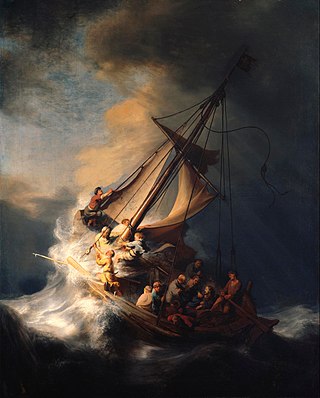
Marine art or maritime art is a form of figurative art that portrays or draws its main inspiration from the sea. Maritime painting is a genre that depicts ships and the sea—a genre particularly strong from the 17th to 19th centuries. In practice the term often covers art showing shipping on rivers and estuaries, beach scenes and all art showing boats, without any rigid distinction - for practical reasons subjects that can be drawn or painted from dry land in fact feature strongly in the genre. Strictly speaking "maritime art" should always include some element of human seafaring, whereas "marine art" would also include pure seascapes with no human element, though this distinction may not be observed in practice.
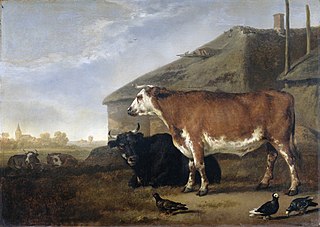
Abraham van Calraet, or Kalraat was a Dutch Golden Age painter and engraver.
Barent van Kalraet, or Barent Pietersz Calraat was a Dutch Golden Age painter and the younger brother of Abraham Calraet.

Benjamin Gerritszoon Cuyp was a Dutch Golden Age landscape painter.
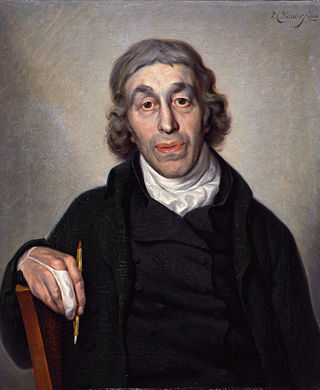
Jacob van Strij was Dutch painter, printmaker, and draftsman who was mainly interested in landscape painting, including mountain landscapes, winter landscapes and marines.

Auguste Bonheur was a French painter of animals and bucolic scenes in landscapes. In his compositions he was able to accurately depict the horizon, ambience, luminous settings and space. His works show the influence of the paintings of cattle by seventeenth-century Dutch painters such as Aelbert Cuyp and Paulus Potter.
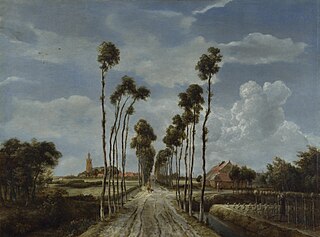
The Avenue at Middelharnis is a Dutch Golden Age painting of 1689 by Meindert Hobbema, now in the National Gallery, London. It is in oil on canvas and measures 103.5 by 141 centimetres. It shows a road leading to the village of Middelharnis on the island of Goeree-Overflakkee in the Meuse delta in South Holland, the Netherlands.
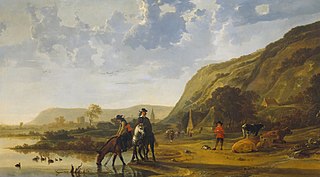
River Landscape with Riders is an oil on canvas painting by the Dutch artist Aelbert Cuyp, created c. 1653-1657, now in the Rijksmuseum in Amsterdam, which bought it in 1965 from the Edmond de Rothschild collection in Exbury, Hampshire. The painting is signed at the bottom center 'A. Cuijp'.

Frans Rijckhals, or François Ryckhals was a Dutch painter and designer. His works combine genre scenes with still-lifes.

Equestrian Portrait of Cornelis and Michiel Pompe van Meerdervoort with Their Tutor and Coachman, also known as Starting for the Hunt, is an oil-on-canvas painting by Aelbert Cuyp, now in the Metropolitan Museum of Art in New York.
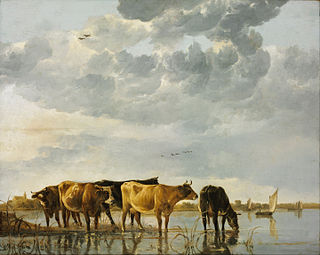
Cows in a River is an oil on canvas painting of 1650 by the Dutch Golden Age artist Aelbert Cuyp.

















